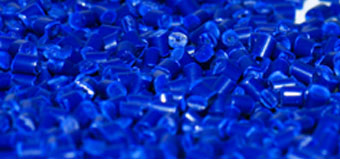Supercritical Fluids and Polymers
Polymers and CO2
CO2 is a good solvent for many non-polar and some polar molecules with low molecular weights but it is a very poor solvent for most high molecular weight polymers at normal operating conditions. Although the solubility of most polymers in CO2 is extremely low, the solubility of CO2 in many polymers is substantial. This can lead to a dramatic decrease in the glass transition temperature (Tg) of these polymers at modest pressures. The plasticization of polymers by CO2 plays a key role when purifying, extracting, foaming, or processing thermally sensitive materials.
CO2 is a good plasticizing agent for a multitude of polymers, including polystyrene, polyethylene, poly-(ethylene terephthalate), polyisoprene, polypropylene, poly(vinyl chloride), nylon and poly(2,6-dimethylphenylene oxide). CO2 has also been shown to plasticize polymethacrylates, polycarbonates, polyurethanes, polyimides, crosslinked elastomers, and a number of block copolymers and polymer blends.
Polymerization Reactions in Supercritical CO2
In heterogeneous polymerization, plasticization increases the diffusion of monomer and initiator into the polymer phase. An example of this effect is the formation of polymer blends by polymerization within a CO2-swollen host polymer.
Polymer Extraction and Purification
Frequently, it is necessary to extract small molecules like plasticizers, antioxidants, UV stabilizers, residual monomers, oligomers, or solvent residues from polymer matrices. Extractions can be required for analytical analyses, improvement of polymer properties, or for regulatory requirements when using polymers for biomedical materials. In many instances, non-toxic supercritical CO2 can be used to replace the toxic organic solvents traditionally used to analyze and process polymeric materials.
Polymer Impregnation and Dyeing (see Dyeing)
The swelling of a polymer matrix with supercritical CO2 is exploited in many infusion, deposition, or impregnation applications. Waterless dyeing of polymeric materials, the formation of polymer blends, and the deposition of organometallic compounds into polymer hosts are a few examples.
Porous Polymer and Microcellular Polymer Foams
Carbon dioxide has been used as a foaming agent for microcellular polymer foams and can eliminate the need for porogenic solvents in the formation of porous polymers. Conventional processes often require large volumes of toxic organic solvents and leave traces of solvent trapped within the polymeric matrix.
Polymer Particles and Nanoparticles (see Nanoparticles)
Although most non-fluorinated polymers have very low solubility in CO2, there are some biodegradable polymers that have limited solubility including poly(lactic acid) PLA and poly(glycolic acid) PGA. The Rapid Expansion of a Supercritical Solution (RESS) technique has been used to form microparticles of these polymers. Nucleation of the dissolved polymers occurs when the supercritical solution is rapidly depressurized to atmosphere.
Since most polymers are not soluble in supercritical CO2, many techniques have been developed using supercritical CO2 as an antisolvent in the formation of nano and microparticles. In these methods, a polymer is dissolved in an organic solvent and when exposed to supercritical CO2 as an antisolvent, polymer particles precipitate in the supercritical CO2 expanded solvent.
Supercritical Blending of Additives into Polymers
The blending of additives into a polymer can be enhanced with supercritical CO2. The dissolution of CO2 into a polymer matrix causes the polymer to swell and lowers the melting temperature of the polymer. Additives can now be easily mixed and distributed with the melted plasticized polymer. Once a homogeneously mixed system is obtained the vessel contents are rapidly depressurized through an orifice resulting in the cooling and solidification of uniform blended particles at low temperatures.
Polymer Coatings
The unusual solubility of amorphous fluoropolymers and silicones in supercritical CO2 makes these materials attractive candidates for “solvent-free” coating applications. The process entails placing a material to be coated into a vessel, dissolving a fluoropolymer or silicone polymer in supercritical CO2, and depressurizing the vessel causing the deposition of the now insoluble polymer on the surface. An alternative technique depressurizes the dissolved polymer through a spray nozzle onto the surface of the material to be coated.

At Applied Separations, we have a proven commitment to advancing Supercritical Fluids technology and have worked with companies all over the world to incorporate SCF into their processes. Thanks to a top-notch R&D team, in-house engineers, and visionary approach, we're working hard to develop and enhance applications of this green technology in many unexpected industries.
Contact us and we'll work with you to develop a supercritical fluid application for your needs.
Download a Supercritical Fluid application: